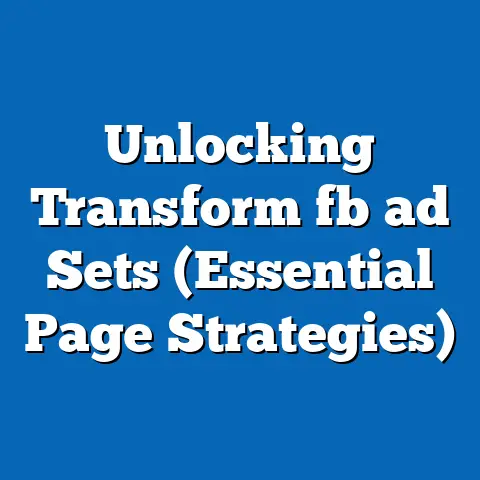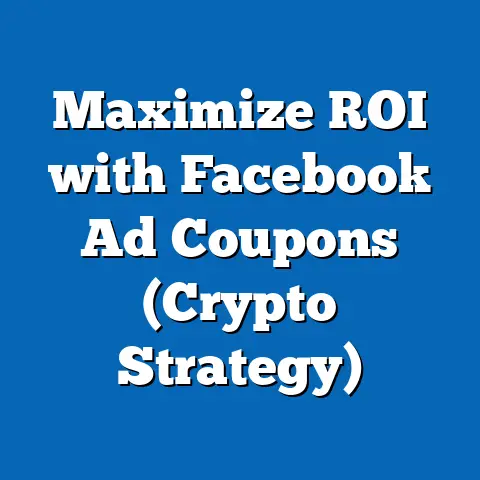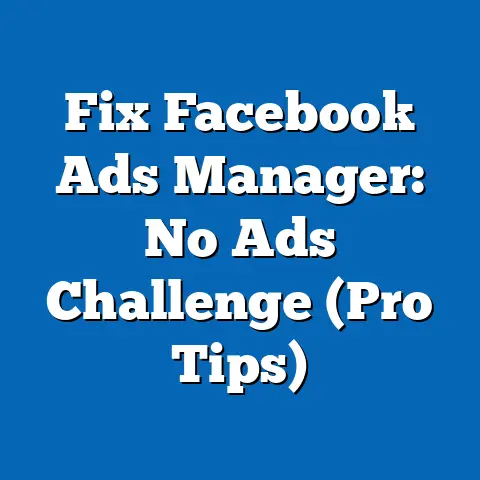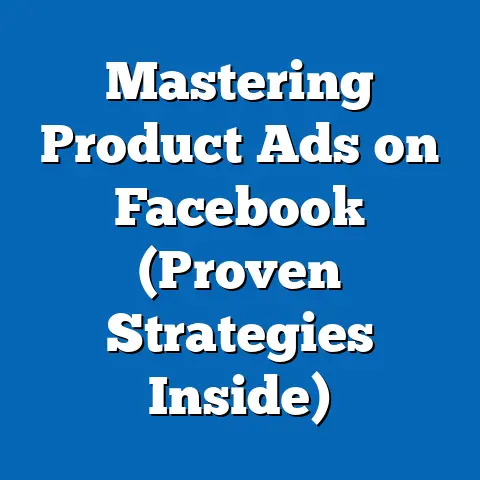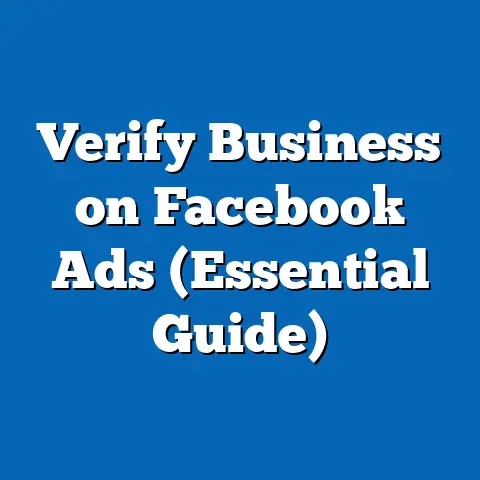Unlock Facebook Ad Interests (Proven Targeting Secrets)
I remember the first time I launched a Facebook ad campaign. I was so excited to get my product in front of as many eyes as possible. I set a broad target audience, thinking, “The more, the merrier!” Boy, was I wrong. My ad spend vanished faster than a free sample at a convention, and the results were… well, let’s just say I learned a valuable lesson: effective Facebook advertising isn’t about casting the widest net, it’s about spearfishing with precision.
Think of digital marketing like a vibrant, bustling marketplace. You wouldn’t set up shop in a random corner and hope the right people stumble upon your products, would you? You’d carefully choose a location where your ideal customers are likely to congregate. That’s precisely what interest targeting allows you to do on Facebook.
In this article, I’ll share the secrets I’ve learned over the years – the proven techniques to unlock Facebook ad interests and connect with the right audience. I’ll guide you through understanding, segmenting, and leveraging interests to create campaigns that resonate, convert, and, most importantly, deliver a healthy return on your investment. Prepare to transform your Facebook advertising from a shot in the dark to a laser-focused beam that hits its mark every time.
Understanding Facebook Ad Interests
Facebook ad interests are the digital breadcrumbs we leave behind as we navigate the platform. They’re based on the pages we like, the groups we join, the topics we engage with, and even the apps we use. Unlike demographics (age, location, gender) or behaviors (purchase history, device usage), interests tap into the core passions and affinities of users.
Think of it this way: demographics tell you who someone is, behaviors tell you what they do, and interests tell you what they care about.
There are two primary categories of interests within Facebook’s advertising platform:
- Broad Interests: These are large, general categories like “Fitness,” “Travel,” “Cooking,” or “Fashion.” They represent widespread interests with a large potential audience.
- Niche Interests: These are more specific and targeted, such as “CrossFit,” “Backpacking,” “Vegan Recipes,” or “Sustainable Fashion.” They cater to smaller, more engaged audiences.
The beauty of interest targeting lies in its ability to connect your ads with users who are genuinely interested in what you have to offer. Facebook constantly analyzes user behavior and engagement to refine these interest categories. Every like, share, comment, and click contributes to shaping and updating these interests, making them a dynamic and powerful tool for advertisers.
Key Takeaway: Facebook ad interests are based on user passions and affinities, offering a powerful way to target specific audiences beyond demographics and behaviors.
The Psychology Behind Interest Targeting
Why is interest targeting so effective? The answer lies in the fundamental principles of psychology.
- Relevance: People are more likely to pay attention to ads that are relevant to their interests. When an ad aligns with their passions, it feels less like an intrusion and more like a helpful suggestion.
- Personalization: In today’s digital landscape, consumers crave personalization. Interest targeting allows you to tailor your ad messaging to resonate with specific audience segments, making them feel understood and valued.
- Confirmation Bias: We all tend to seek out information that confirms our existing beliefs and interests. By targeting users based on their interests, you’re tapping into this natural tendency, increasing the likelihood that they’ll engage with your ad.
Understanding consumer behavior is crucial for successful interest targeting. Consider this: a fitness enthusiast interested in “CrossFit” might respond well to ads featuring high-intensity workout gear or protein supplements. However, they might be less interested in generic fitness apparel. On the other hand, someone interested in “Yoga” might be more receptive to ads for mindfulness apps or organic tea.
I once worked with a client who sold handmade jewelry. Initially, they targeted a broad audience based on demographics like “women aged 25-45.” The results were underwhelming. However, after analyzing their customer data, we discovered that many of their customers were also interested in “Bohemian Fashion,” “Yoga,” and “Meditation.” By targeting these interests, we saw a significant increase in engagement and sales.
Key Takeaway: Interest targeting leverages psychological principles like relevance, personalization, and confirmation bias to connect with audiences on a deeper level.
Proven Targeting Secrets to Unlock Facebook Ad Interests
Now, let’s dive into the practical techniques you can use to unlock the full potential of Facebook ad interests.
1. Segment and Analyze Your Audience
Before you start targeting interests, you need to understand who your ideal customer is. Audience segmentation is the process of dividing your target audience into smaller, more homogeneous groups based on shared characteristics.
Here’s how I approach audience segmentation and analysis:
- Analyze Existing Customer Data: Look at your existing customer base. What are their demographics, purchase history, and interests? Use tools like your CRM (Customer Relationship Management) system, email marketing platform, and website analytics to gather this data.
- Use Facebook Audience Insights: This free tool provides valuable insights into the demographics, interests, and behaviors of people on Facebook. You can use it to explore potential target audiences and identify relevant interests.
- Conduct Surveys and Polls: Ask your customers about their interests, hobbies, and passions. This direct feedback can provide valuable insights that you might not find elsewhere.
- Leverage Google Analytics: Analyze your website traffic to see which pages are most popular and what keywords are driving traffic to your site. This can give you clues about the interests of your website visitors.
Once you’ve gathered this data, look for patterns and trends. Are there specific interests that are common among your customers? Are there any surprising or unexpected interests that you hadn’t considered?
Example: Let’s say you sell organic coffee beans. After analyzing your customer data, you discover that many of your customers are also interested in “Sustainable Living,” “Fair Trade,” and “Minimalism.” These interests can inform your Facebook ad targeting strategy.
Key Takeaway: Audience segmentation and analysis are crucial for identifying the right interests to target on Facebook.
2. Utilize Lookalike Audiences
Lookalike audiences are one of Facebook’s most powerful targeting tools. They allow you to reach new people who are similar to your existing customers.
Here’s how it works:
- Create a Source Audience: This is the audience that Facebook will use to find similar people. You can use your existing customer list, website visitors, or even people who have engaged with your Facebook page.
- Choose a Lookalike Audience Size: You can choose a percentage of the population to target. A smaller percentage (e.g., 1%) will result in a more precise match, while a larger percentage (e.g., 10%) will reach a broader audience.
- Let Facebook Do Its Magic: Facebook will analyze the characteristics of your source audience and find new people who share similar demographics, interests, and behaviors.
I’ve seen lookalike audiences deliver incredible results for my clients. One client, who sold online courses, saw a 300% increase in leads after implementing lookalike targeting.
Case Study: A local bakery wanted to expand its reach. They created a lookalike audience based on their existing customers and targeted people who were interested in “Baking,” “Desserts,” and “Local Food.” The campaign resulted in a significant increase in foot traffic and online orders.
Key Takeaway: Lookalike audiences are a powerful way to reach new people who are similar to your existing customers, leveraging Facebook’s algorithm to find the right audience.
3. Leverage Competitor Analysis
Your competitors are a valuable source of information. By analyzing their ad strategies, you can uncover potential interest categories that you might not have considered.
Here are some techniques for spying on your competitors’ ads:
- Facebook Ad Library: This free tool allows you to see all the ads that a Facebook page is currently running. You can use it to see what interests your competitors are targeting and what messaging they’re using.
- Third-Party Ad Spy Tools: There are several paid tools that can provide more in-depth analysis of your competitors’ ad strategies. These tools can help you identify which ads are performing best and what targeting options they’re using.
- Subscribe to Competitor’s Email List: Sign up for your competitors’ email lists to see what promotions and offers they’re sending to their subscribers. This can give you clues about their target audience and their marketing strategies.
- Follow Competitors on Social Media: Pay attention to the content that your competitors are posting on social media. This can give you insights into their target audience and their overall marketing strategy.
Remember, the goal is not to copy your competitors’ strategies, but to learn from them and adapt their techniques to your own business.
Key Takeaway: Competitor analysis can help you uncover potential interest categories and refine your targeting strategies.
4. Test and Iterate
The key to successful Facebook advertising is constant testing and iteration. Don’t assume that you know what will work best. Instead, test different interest combinations, ad creatives, and messaging to see what resonates with your audience.
Here’s how to set up effective A/B tests:
- Choose a Variable to Test: Focus on testing one variable at a time, such as the interest category, ad creative, or headline.
- Create Two Versions of Your Ad: Create two versions of your ad that are identical except for the variable you’re testing.
- Set Up Your Campaign: Use Facebook’s A/B testing feature to split your audience between the two versions of your ad.
- Track Your Results: Monitor the performance of each version of your ad and track key metrics like click-through rate, conversion rate, and cost per acquisition.
- Analyze Your Results: Once you’ve gathered enough data, analyze your results to see which version of your ad performed better.
- Implement Your Findings: Use your findings to optimize your ad campaigns and improve your results.
I always tell my clients that Facebook advertising is a journey, not a destination. The more you test and iterate, the better you’ll understand your audience and the more successful your campaigns will be.
Key Takeaway: A/B testing is crucial for determining what works best and optimizing your Facebook ad campaigns for maximum performance.
Advanced Targeting Techniques
Once you’ve mastered the basics of interest targeting, you can start experimenting with more advanced techniques.
Layering Interests
Layering interests involves targeting multiple interests within a single ad set. This allows you to create highly targeted ads that reach a specific niche audience.
For example, let’s say you sell hiking gear. You could layer the interests “Hiking,” “Camping,” and “Outdoor Adventure” to target people who are passionate about all three activities.
The potential benefits of layering interests include:
- Increased Relevance: By targeting multiple interests, you can create ads that are highly relevant to your audience.
- Improved Engagement: Relevant ads are more likely to capture the attention of your audience and encourage them to engage with your ad.
- Higher Conversion Rates: When your ads are highly relevant and engaging, you’re more likely to see higher conversion rates.
However, it’s important to be careful when layering interests. If you layer too many interests, you can narrow your audience too much and limit your reach.
Key Takeaway: Layering interests can help you create highly targeted ads that reach a specific niche audience, but it’s important to avoid narrowing your audience too much.
Custom Audiences
Custom audiences allow you to target people who have already interacted with your business. You can create custom audiences based on your customer list, website visitors, app users, or people who have engaged with your Facebook page.
Custom audiences can be used alongside interest targeting to create more precise and effective campaigns. For example, you could target people who have visited your website and are also interested in “Sustainable Fashion.”
Retargeting is a powerful strategy that involves showing ads to people who have previously interacted with your business. This can be an effective way to re-engage users who have shown interest in your products or services but haven’t yet made a purchase.
Key Takeaway: Custom audiences allow you to target people who have already interacted with your business, and retargeting strategies can re-engage users who have shown interest in your products or services.
Utilizing Behavioral Targeting
Behavioral targeting complements interest targeting by focusing on user actions. Facebook tracks a wide range of user behaviors, such as purchase history, device usage, and travel patterns.
You can use behavioral targeting to reach people who are likely to be interested in your products or services based on their past actions. For example, you could target people who have recently purchased hiking gear online or people who have traveled to national parks.
Merging interests with behaviors can create even more effective campaigns. For example, you could target people who are interested in “Sustainable Living” and have also purchased organic food online.
Key Takeaway: Behavioral targeting complements interest targeting by focusing on user actions, allowing you to create more effective campaigns by merging interests with behaviors.
Case Studies and Examples
Let’s look at some real-life examples of brands that have successfully unlocked Facebook ad interests.
- Example 1: A Fitness App: A fitness app targeted users interested in “Yoga,” “Meditation,” and “Mindfulness.” They created ads featuring calming visuals and messaging that emphasized the app’s stress-reducing benefits. The campaign resulted in a significant increase in app downloads and subscriptions.
- Example 2: An E-commerce Store: An e-commerce store that sells handmade jewelry targeted users interested in “Bohemian Fashion,” “Vintage Jewelry,” and “Artisan Crafts.” They created ads featuring high-quality photos of their jewelry and messaging that emphasized the unique and handcrafted nature of their products. The campaign resulted in a significant increase in online sales.
- Example 3: A Local Restaurant: A local restaurant targeted users interested in “Local Food,” “Fine Dining,” and “Wine Tasting.” They created ads featuring mouth-watering photos of their dishes and messaging that emphasized the restaurant’s fresh ingredients and unique atmosphere. The campaign resulted in a significant increase in foot traffic and reservations.
These case studies demonstrate the power of interest targeting when combined with relevant ad creatives and messaging. By understanding your audience and crafting ads that resonate with their interests, you can achieve remarkable results.
Conclusion
Mastering Facebook ad interest targeting is a crucial skill for any digital marketer. By understanding the psychology behind interest targeting, segmenting your audience, utilizing lookalike audiences, leveraging competitor analysis, and testing and iterating, you can unlock the full potential of Facebook advertising.
I encourage you to apply the techniques shared in this article to your own campaigns. Experiment with different interest combinations, ad creatives, and messaging to see what works best for your business. Remember, the key to success is to constantly learn, adapt, and refine your strategies.
So, go forth and unlock your own advertising potential on Facebook! The world of digital marketing awaits your expertise and innovative campaigns.

